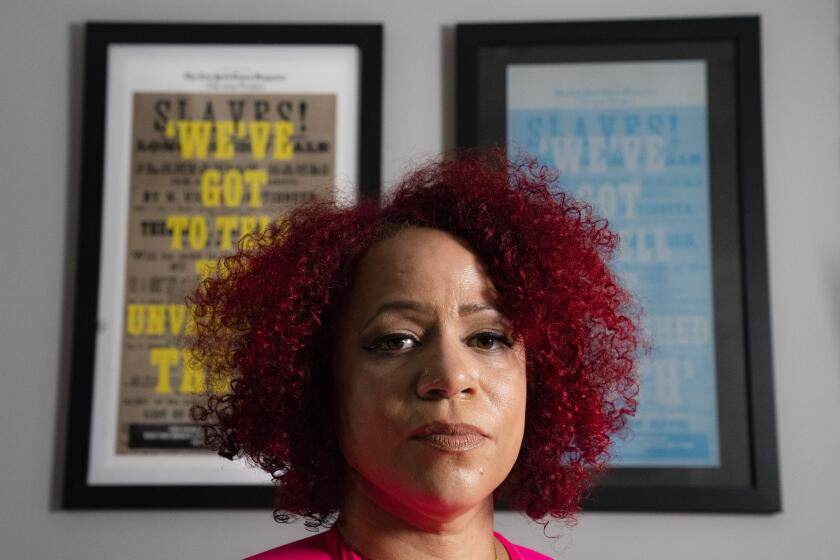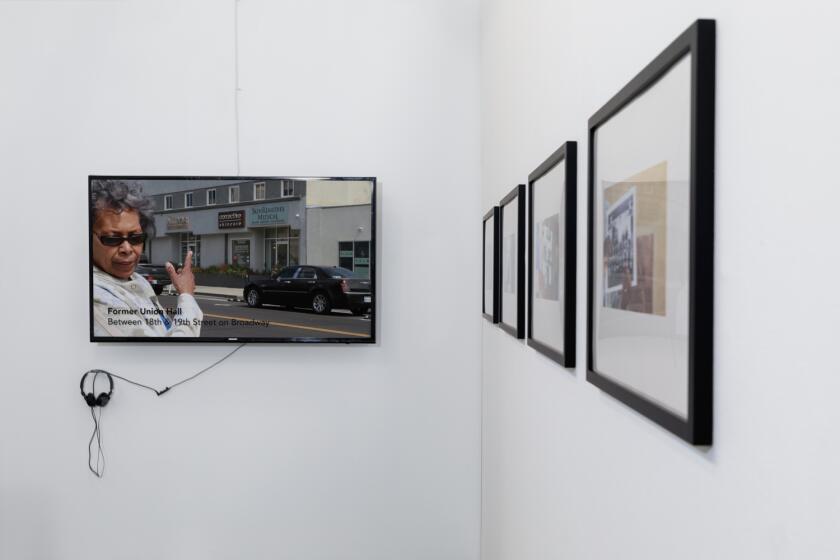Pussy Riot founder uses art and ashes as ammo for an anti-Putin exhibit
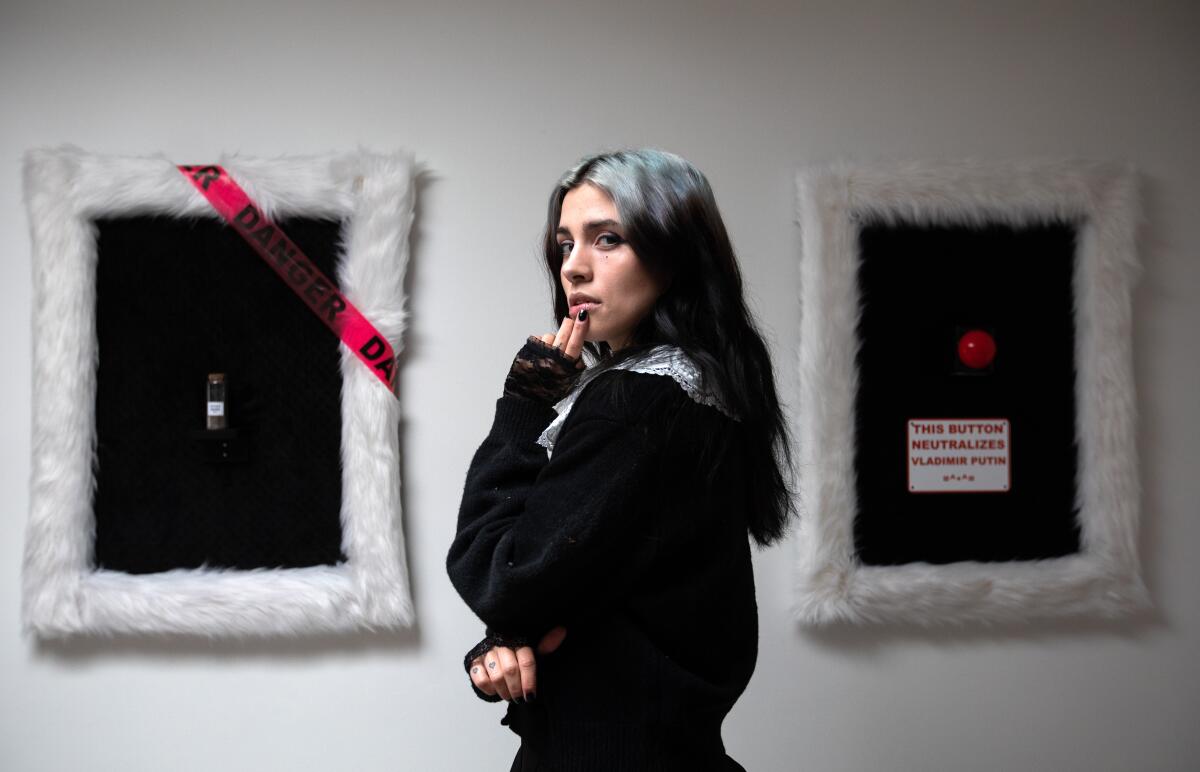
In an upstairs corner of the Jeffrey Deitch gallery, Nadya Tolokonnikova steps quietly into a dark, closet-size vault where the founder of the Pussy Riot art collective has mounted three vials of ashes to canvases on the walls. They hang within frames covered in fuzzy faux-fur and have labels helpfully marked with measurements: “5 grams,” “30 grams” and “100 grams.”
“This is the mausoleum of Putin,” says Tolokonnikova, sounding more playful than solemn, describing this small part of her art installation, “Putin’s Ashes,” a weeklong exhibition of political agitprop aimed against the Russian president opening Friday.
The vault represents a tiny echo of the Lenin mausoleum in Moscow’s Red Square. In an adjacent room she has mounted more pieces with industrial-size switches and buttons — the kind that might launch a missile or detonate a bomb. One red button is accompanied by the words: “This button neutralizes Vladimir Putin.” Another reads: “This button eliminates sexism.”
“It’s a part of magic-activist-thinking to me,” explains Tolokonnikova, 33, whose messages focus on feminism and against the Russian leader now waging war against Ukraine. “I think sometimes you need to be a little bit silly and use irony and laughter to overcome dangerous dictators.”
As part of the Friday opening of “Putin’s Ashes,” installed in the Santa Monica Boulevard wing of Deitch’s gallery, an evening protest will be held on the sidewalk. That evening, entry will be granted only to people wearing a balaclava like those that Pussy Riot made famous. (Masks will be available at the door as long as supplies last.) The show closes Feb. 3. A trailer for the exhibit was released in time for the opening.
The event is an extension of an August ritual that Tolokonnikova led on a barren desert landscape, gathering 11 other women in matching red masks, black slips and fishnet stockings. Most of the women were from Russia, Ukraine or Belarus, and together they burned a 10-by-10 foot painting of President Putin.
A sophisticated video was shot of the event, with meditative music created by Tolokonnikova. Rather than post the finished video on YouTube — as she has for several other message-fueled pieces — she wanted a way to underline the seriousness intended, as both politics and art. Presenting “Putin’s Ashes” in an art gallery provides that, she says.
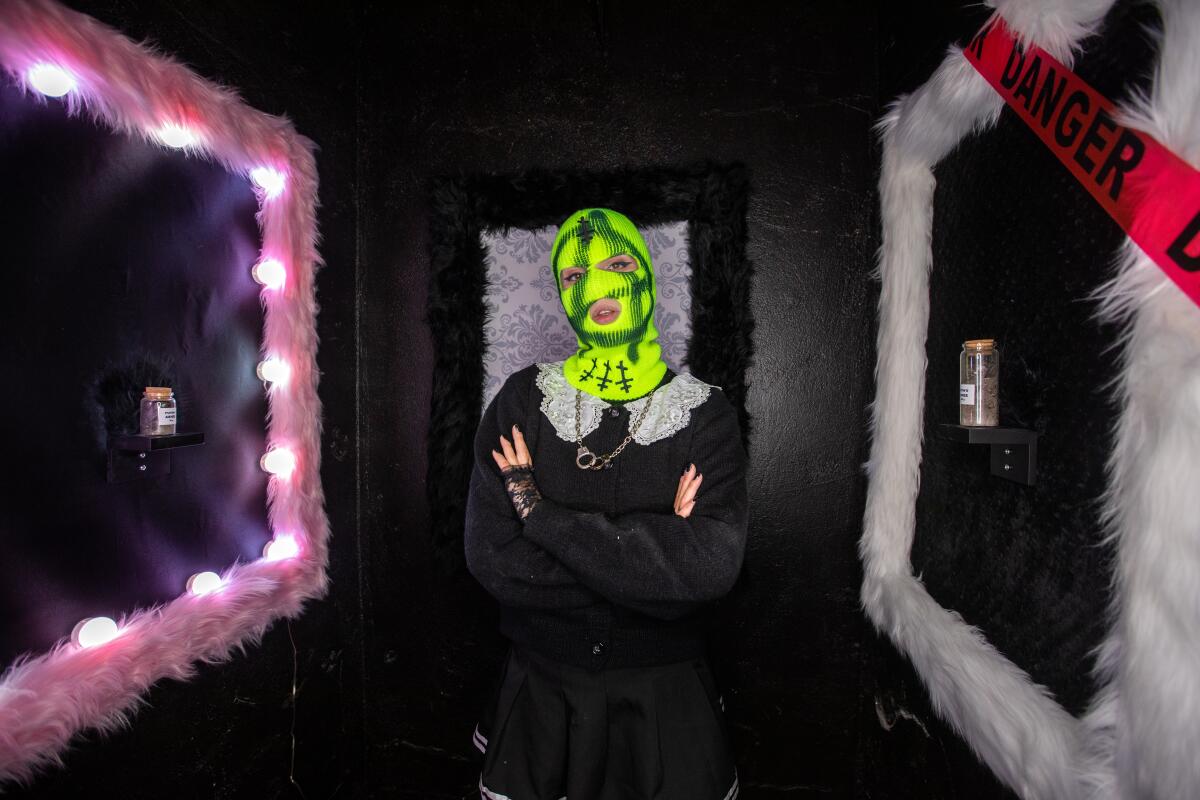
“I want everyone to have access to it for free and for every part of the world, but I also want to place it in a context where people dig a little bit deeper,” Tolokonnikova explains, dressed in her typical anime-influenced attire: a black skirt and sweater with white frilly collar, black lace gloves and black sneakers with 2-inch soles. “If you just release it on YouTube, it’s going to be labeled a music video.”
She found a venue for “Putin’s Ashes” with contemporary art dealer and curator Deitch, a collaboration that followed years of conversations.
“My dialogue with her is like any serious artist. It’s not superficial in any way,” says Deitch, who first met the Pussy Riot activist at Art Basel in Miami. “We’re talking the same way as I talk with an ambitious painter, sculptor, theater director. She has a vision.”
Pussy Riot rose from an obscure Moscow activist group to become an international force through the chaotic performance of its “Punk Prayer” at Moscow’s Christ the Savior Cathedral in February 2012. The young women arrived in knitted, brightly colored balaclavas, dancing and pumping their fists, as their song echoed within the ornate cathedral walls. Several members of the group were arrested and charged with “hooliganism motivated by religious hatred,” and ultimately Tolokonnikova and her Pussy Riot comrade Maria Alyokhina were sentenced in 2012 to two years in prison.
“That’s one of the most significant art performance projects with a political purpose that I’ve experienced in the past few decades,” Deitch says. “I was very, very inspired by that.”
In action, Deitch adds, Pussy Riot is in the tradition of the Situationist International, the midcentury avant-garde movement that collided art and radical politics. It also reminded him of the comical 1960s antiwar protests of the Yippies, led by Abbie Hoffman and Jerry Rubin, and the provocative public performances of the Sex Pistols and Public Image Ltd. amid ’70s social and political turmoil in the UK.
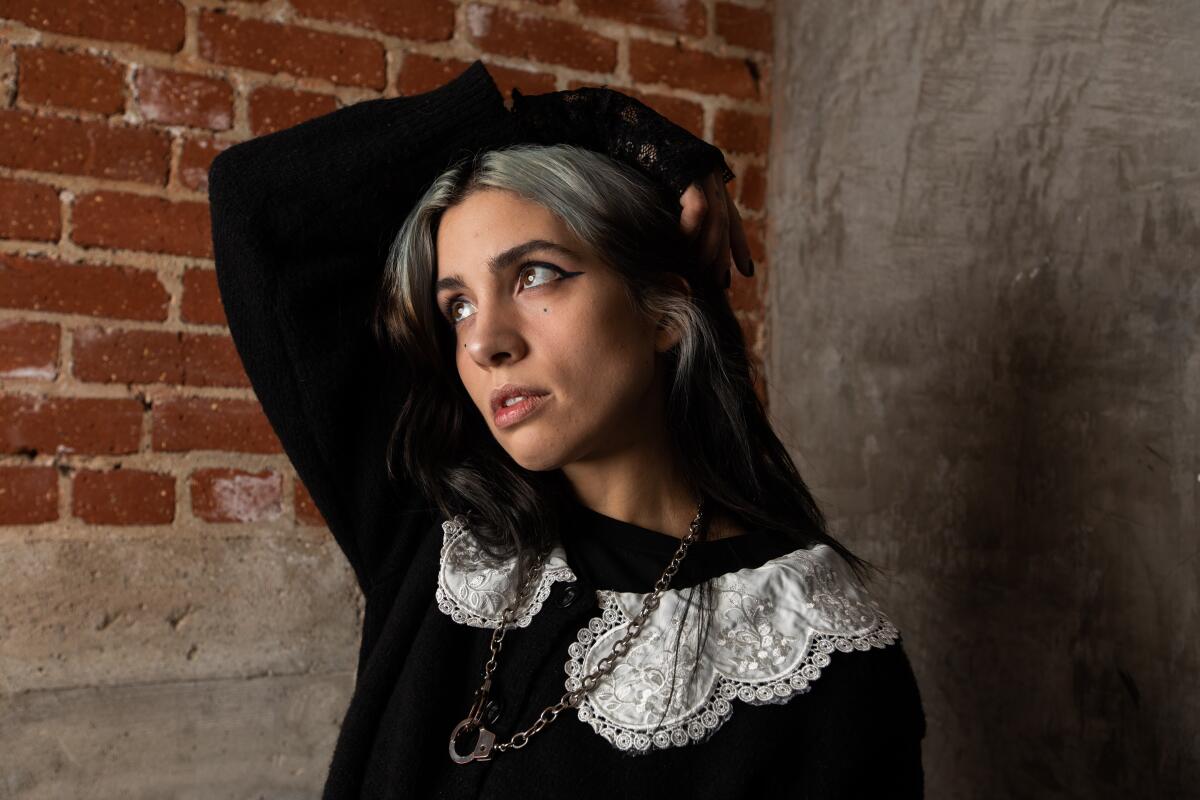
“They really had impact on the society,” Deitch says. “Pussy Riot is in that tradition, and I think there will be a lot of more. I’m very honored to be giving Pussy Riot a platform.”
Tolokonnikova’s first trip to Los Angeles was nine years ago, just months after and she and Alyokhina were released from a Russian prison. Memories from that year are clouded, she says, from the clinical depression she was later diagnosed with, but she made lasting connections in the city, including with the artist Shepard Fairey.
They sat together for a well-attended panel discussion at Mack Sennett Studios about Pussy Riot’s experiences and calls for prison reform. Like many artists, Fairey was struck by the searing image of political purpose represented by the activist group, recognizable for its balaclavas. Fairey compares it to the iconic 1960 portrait of Che Guevara, bearded and in a beret, photographed by Alberto Korda, that has appeared on countless banners and posters for decades since.
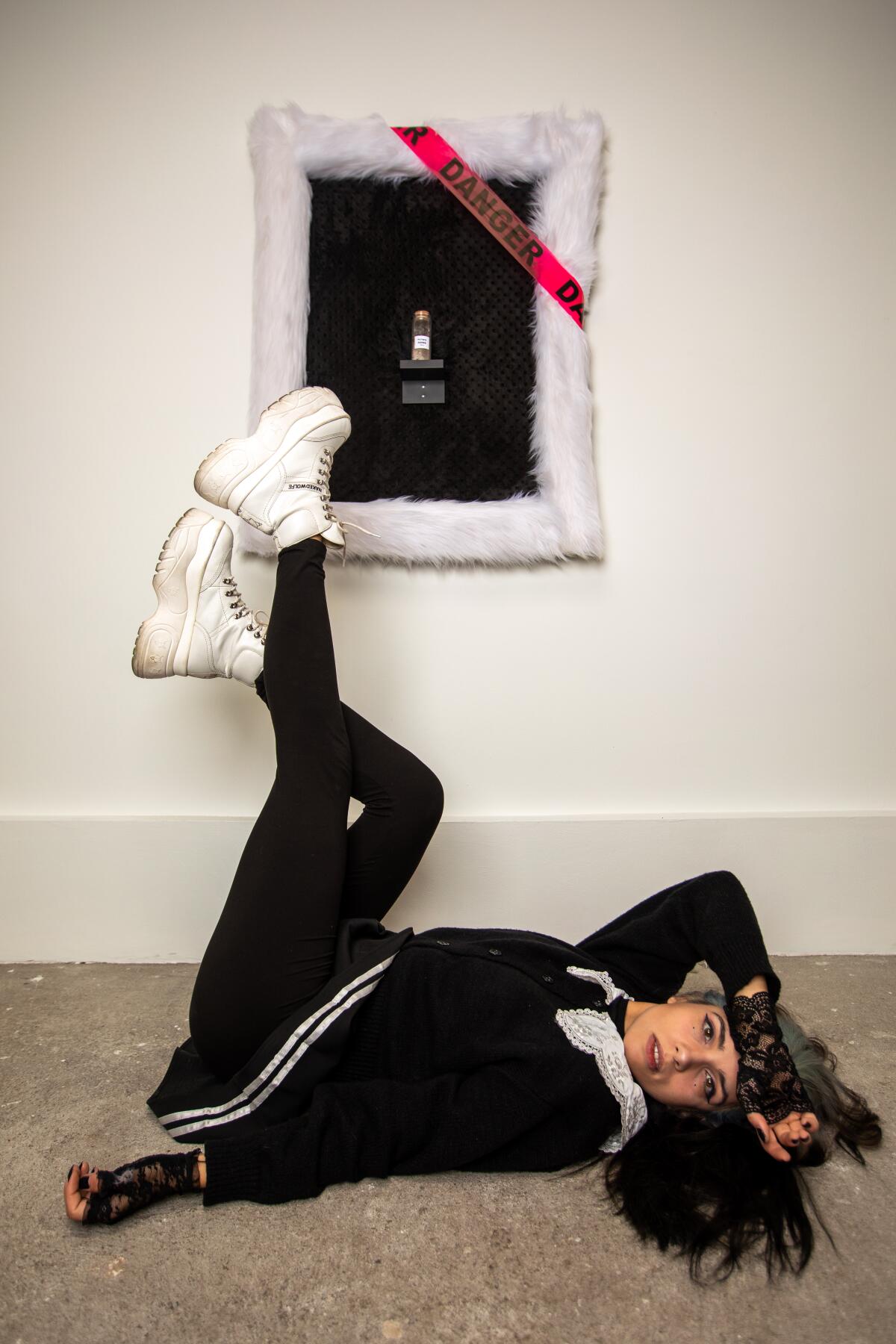
For “Pussy Riot: Putin’s Ashes,” Fairey created a fiery poster art in shades of black, white and pink, and he is now collaborating with Tolokonnikova on an NFT that will raise money in support of Ukraine. “Nadya is really compelling. She’s a beautiful woman who is fiercely intelligent, courageous. She’s the archetype,” Fairey says. “I think that a lot of times people need to be moved by style and emotion before they get to substance, and she’s capable of delivering all of it — and that’s a rare thing.”
Tolokonnikova’s ex-husband, Pyotr Verzilov, is currently working on a documentary on the front lines of the Russia/Ukraine war, so she’s heard reports that many of their fellow Russians support the conflict. “It’s really painful for me to realize that some people in my country actually want this unjust war,” she says, hoping to represent another constituency and demonstrate by example. “Russia is not just those terrible monsters who support the war, who support Vladimir Putin, people who just blindly believe propaganda. Another Russia exists.”
In Los Angeles, Tolokonnikova says she doesn’t take the support of a prominent gallery for her message lightly, particularly considering her subject matter.
“I’m talking about Putin’s death. It’s a dangerous topic to talk about, and Jeffrey didn’t shy away,” Tolokonnikova says. “I’ve seen numerous people who pose as punk rockers, but they would not even appear with me in the same picture because they would be scared of their tour getting canceled in Russia or their ticket sales are going to be lower in Russia. Just ridiculous.”
As a lasting result of her imprisonment and other abuses — such as being publicly whipped in front of news cameras by members of the Cossack militia during a protest at the 2014 Winter Olympics in Sochi — Tolokonnikova still suffers from depression. “When I go to see my doctor, he is like, ‘You really have to do less, because you cannot single-handedly save the world,’” she says with a knowing laugh. “I was like, no, but somebody has to start it.”
In part for safety reasons, Tolokonnikova does not discuss where she lives. (It’s notable that many Russian political figures have been assassinated or mysteriously fallen out of windows.) She’s also taken some inspiration from the anonymity that the street artist Banksy continues to work under and hopes to reclaim some of the privacy shattered by her very public trial and its aftermath.
But she’s clearly found a welcoming place in the United States in the art world. In December, she appeared with artist Judy Chicago on a panel at Art Basel and unveiled a textile-based collaboration titled “What If Women Ruled the World?”
Chicago, a groundbreaking feminist artist, met the Pussy Riot creator after reading Tolokonnikova’s book, “Read and Riot,” which Chicago says included “numerous passages that could have been said by me.”
“It has been amazing to connect so deeply with Nadya across generations, geography, culture and experience,” Chicago adds via email. “She has experienced directly the hideous behavior of an autocratic patriarchal leader. What she endured reminded me of the 19th/20th century suffragettes who were imprisoned and force fed because of their struggle for human rights for women. I greatly admire her courage.”
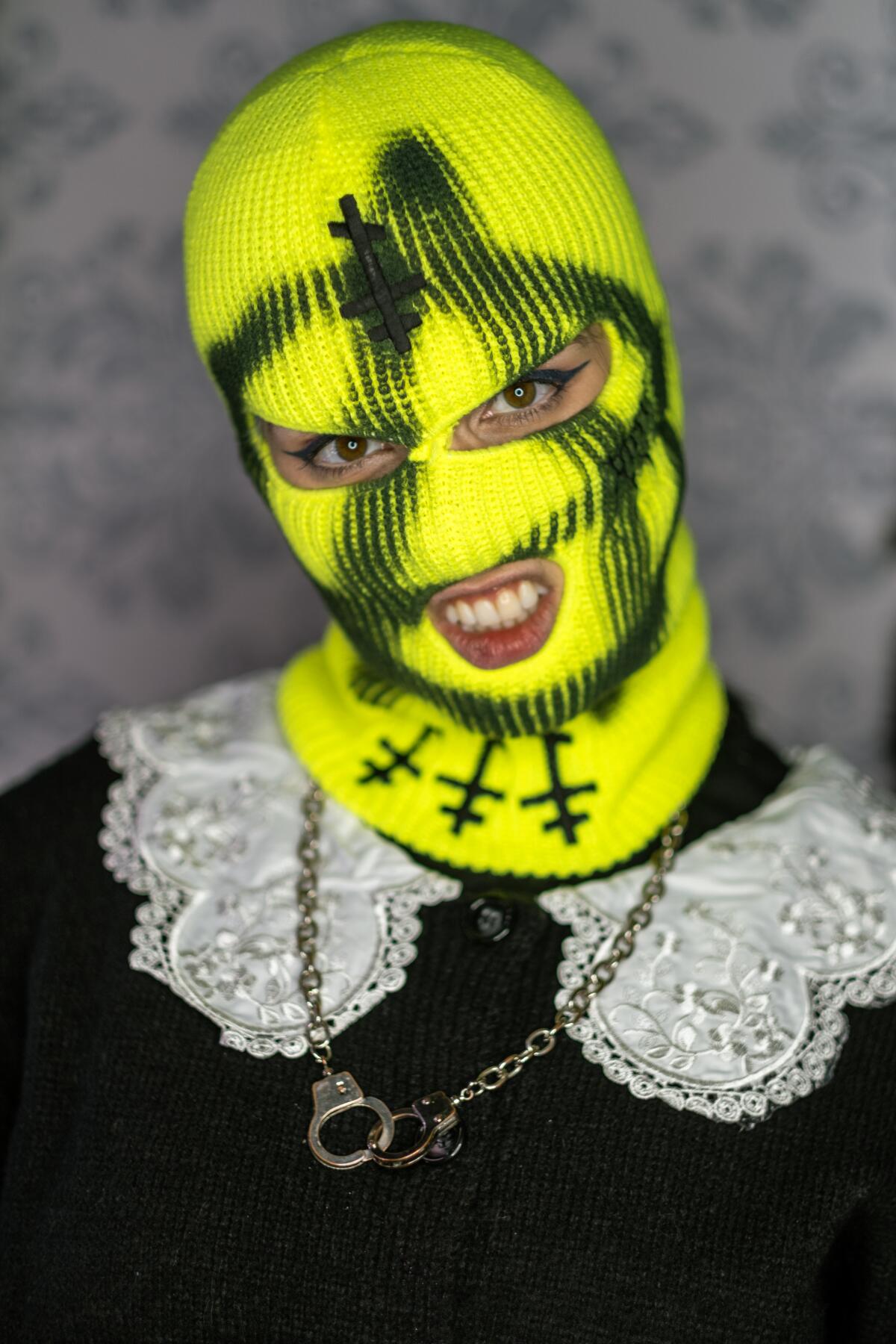
Because Pussy Riot first emerged internationally as a result of the dramatic performance of a song, the misconception that the group is a band has lingered for years. Although Tolokonnikova did study classical piano for eight years while growing up in Russia, little of that knowledge made its way into “Punk Prayer,” which was held together more from social-political conviction than musical skill or inspiration.
“When we created ‘Punk Prayer,’ we didn’t really know how to produce music,” she says, noting that the song was created for a specific purpose. “We created a fake punk band and it was a conceptual art project.”
Even so, music has remained an ongoing part of her repertoire, and last year she released several songs as Pussy Riot on a mixtape of pop and dance music collaborations, including with Tove Lo, Big Freedia and ILoveMakonnen. Tolokonnikova also performed concerts in several cities, including Los Angeles at the El Rey Theater last August, though it was less a traditional tour than a scattered series of one-off performances that were filled with antiwar, anti-Putin and feminist messages under the slogan “Matriarchy Now!”
“I would consider her a multimedia artist and activist,” says Fairey, a punk devotee who frequently celebrates and collaborates with musicians. “She’s going to use any vehicle, any platform that makes sense to convey a message — a spirit of protest, activism and defiance against oppression. Music is a really visceral way to achieve that, but it’s certainly not the only way. It’s maybe missing the point of what Nadya and Pussy Riot are trying to do if one looks at it as a music group.”
A decade after their trial and imprisonment, the original group of Pussy Riot activists in Moscow now operates mostly independently. As Tolokonnikova travels widely, she’s found a supportive creative community in the West. She still regularly links to Alyokhina’s activities and press appearances, but they are following their own paths.
“We are comrades. It’s really different from being friends, and it was really annoying for both of us that people started to pursue us almost like t.A.T.u. the band,” she says, referring to the glossy Russian pop duo. “We’re individual people who come together to create political art, but not more than that.”
Their movement has expanded beyond their original group, and Tolokonnikova recently learned of a young woman in Siberia who made a masked one-person protest against the war from the balcony of an apartment building. “Nobody knew her. So it was just completely organic,” she says. “Especially when it happens in Russia, it’s so dear to me because it’s so dangerous to protest there.”
'Pussy Riot: Putin’s Ashes'
Where: Jeffrey Deitch Gallery, 7000 Santa Monica Blvd., Los Angeles
When: Opening reception 6 to 8 p.m. Jan. 27. Special protest performance at 7 p.m. Continues 11 a.m. to 6 p.m. Saturday and Tuesday through Feb. 3.
Free
Info: deitch.com/los-angeles/exhibitions, (323) 925-3000
More to Read
The biggest entertainment stories
Get our big stories about Hollywood, film, television, music, arts, culture and more right in your inbox as soon as they publish.
You may occasionally receive promotional content from the Los Angeles Times.
